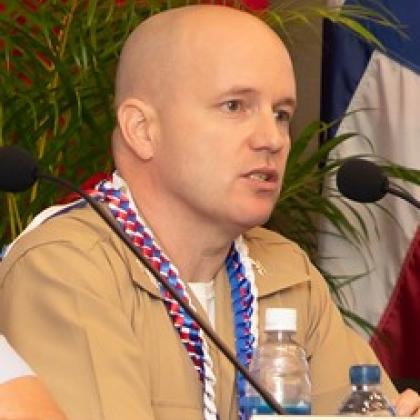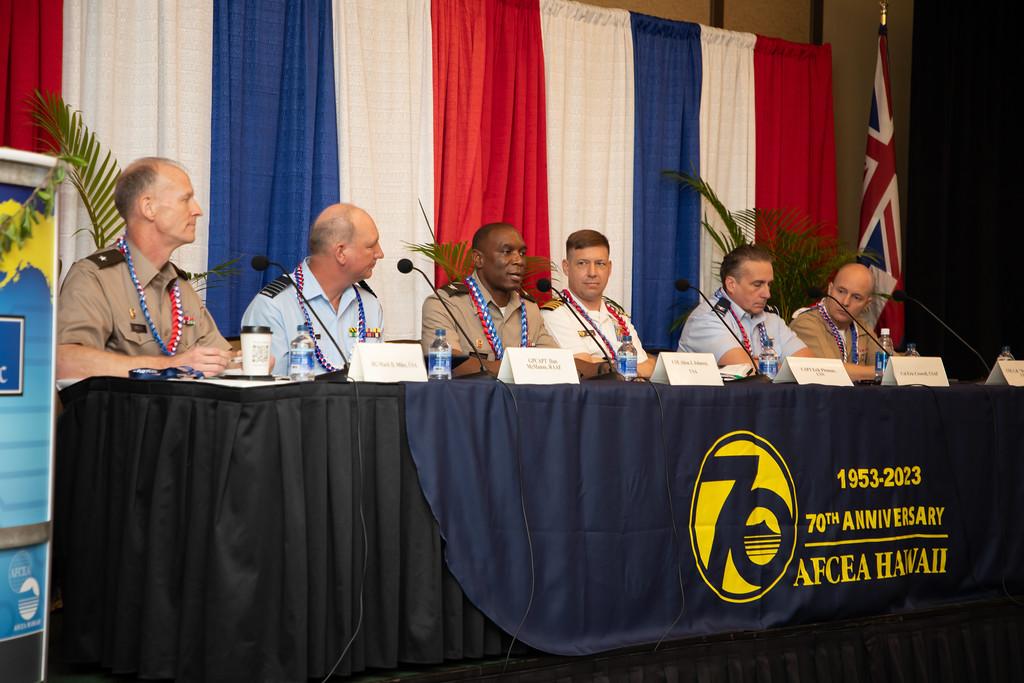Seeking Synchronicity for Assured C2 in the Indo-Pacific Region
Military leaders from Australia and the U.S. military services seek technical and operational synchronicity among varied mission areas to assure command and control (C2) across the vast Indo-Pacific region.
Synchronicity was one of the common themes emerging from a panel discussion of assured C2 in a denied, degraded, interdicted and limited environment during the final day of the AFCEA TechNet Indo-Pacific conference, November 7-9 in Honolulu, Hawaii. The panel included Brig. Gen. Mark Miles, director, command, control, communications and cyber directorate, J6, U.S. Indo-Pacific Command; Col. L. R. “Ray” Gerber, USMC, director, G6, U.S. Marine Corps Forces Pacific; Group Capt. Dan McManus, Royal Australian Air Force, director, General Cyber Warfare and Networks, HQJOC J6 Branch; Col. Eric Crowell, USAF, deputy director, communications and cyber operations, A6, U.S. Pacific Air Forces; and Col. Alton Johnson, USA, director, G6, U.S. Army Pacific.
Gen. Miles, the panel moderator, first mentioned synchronicity during his opening remarks. He recalled that during the summer Pacific Sentry exercise, his first large bilateral exercise in his current assignment, officials ran into complexities at the combatant command level that they hadn’t encountered before. “A lesson that we learned early on is the importance of synchronizing our network functions—of course, your traditional communications, your operations, control of all the different networks, from technical up to strategic—but synchronizing that with cyber, with [electronic warfare], with space in order to have a C2 picture and to ensure that the commander's decision cycle is intact.”
The initial intent was to synchronize efforts each day. “And it was obvious by about day two that once-a-day synchronizing around an operation and intel brief was not enough. Those four functions with the adversaries that we had with the ability to stress those environments across the board, and the agility that the adversary had to do to make an impact in real time, that synchronization and that capability had to be as close to real time as we could make it. We had to have that synchronization between those four functions,” Gen. Miles reported.
Ten years ago, those four functions were “all in one directory,” but that technology has advanced and complexity increased during that time, he indicated, asking industry for assistance. He added that industry has “the tools, the processes, the doctrine, the policy, the training, that synchronize those areas, as we're going into the future because those areas just become more complex.”
And even though industry doesn’t determine policy and doctrine, operational capabilities affect both, he added, asking industry for help with policy and doctrine as well as technical capabilities.
Capt. McManus reported that the Australian Defense Force (ADF) needs synchronicity across cyber, electronic warfare and kinetic mission areas. The ADF is developing a new concept of cyber response options that will take a “maneuver approach,” allowing the Australian military to be more proactive as well as reactive. By proactively responding, the ADF can take away an adversary’s initiative. The new concept also opens up possibilities for deception operations, such as efforts to “conceal, reveal and misdirect.”
The maneuver approach also requires “a greater level of information exchange requirements” and “greater level of coordination across the network to synchronize and execute these response options,” he said.

If I can't talk to my allies, like damn, I don't know really what I'm doing here.
Next year, the ADF is “taking a big leap of faith” and establishing a new cyber component responsible for the planning and execution of missions across network operations, offensive and defense cyber operations and electromagnetic spectrum operations.
Organizationally, it would be similar to the United States combining U.S. Indo-Pacific Command’s J6 and J39 with the Defense Information Systems Agency’s Indo-Pacific organization and elements of the cyber mission force. “So, from next year, we'll have a single accountable officer that has command of all fixed and deployed networks, and being a peer to the other components, the cyber component can synchronize those cyber response options,” he said.
Col. Gerber brought up another form of synchronicity when he noted that the panelists from different military services and countries could deliver similar messages. “As we prepared for this panel, I realized that we could probably trade note cards—notwithstanding anybody's inability to read my handwriting—and any one of us could probably talk about the issues that the other person on this panel was going to talk to because each one of them hits our equities.”
He suggested the needs of all the panelists are intertwined, especially in the Indo-Pacific. “Being in the Pacific arena is inherently combined. It first starts with our partners and allies. And then it's joint. And then, for me, it's naval as part of the joint force maritime component, for example, before it ever gets to be Marine. If I can't talk to my allies, like damn, I don't know really what I'm doing here.”




Comments